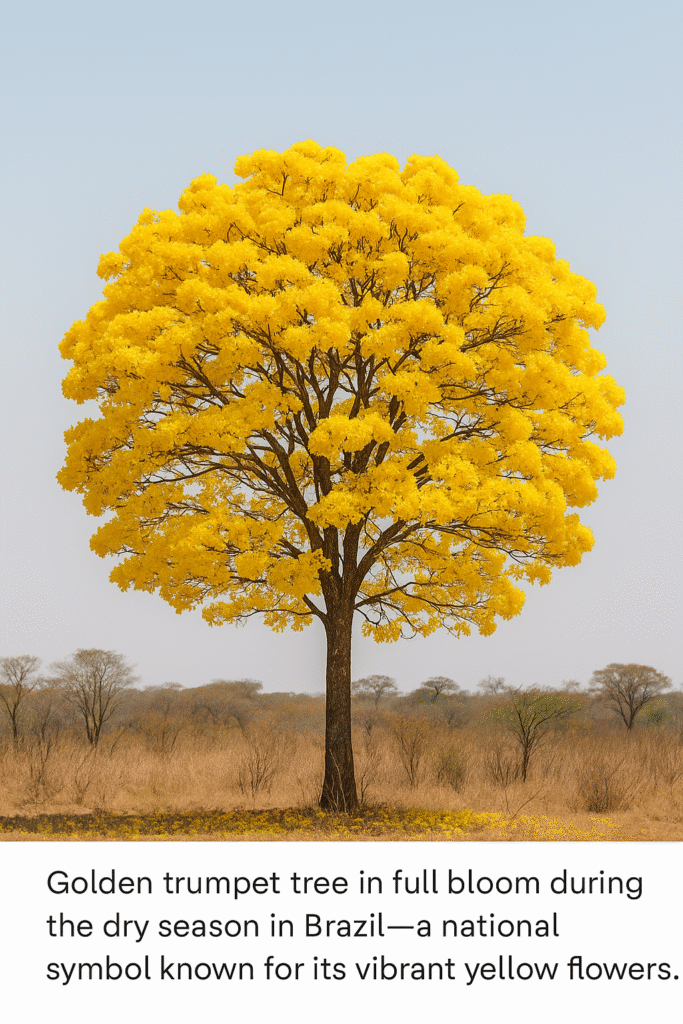The golden trumpet tree, scientifically known as Handroanthus albus (formerly Tabebuia alba), is one of the most iconic and beloved trees in Brazil. Its brilliant yellow blooms transform landscapes into golden carpets during the dry season, attracting admiration and symbolism alike.
In this article, you’ll discover the main characteristics of the golden trumpet tree, where it grows, interesting facts about its cultural role, its ecological value, and tips for growing it at home or in urban areas.
🌼 Key Characteristics of the Golden Trumpet Tree
The golden trumpet tree is a medium-to-large native tree that can grow up to 30 meters tall. It sheds its leaves during the dry season, and then—seemingly overnight—bursts into bloom with thousands of trumpet-shaped golden flowers. This dramatic transformation makes it one of the most visually stunning trees in South America.
Main features:
- Scientific name: Handroanthus albus
- Height: 7 to 30 meters
- Flowering season: August to September (dry season in Brazil)
- Leaves: Deciduous
- Fruits: Long pods with winged seeds dispersed by wind
- Family: Bignoniaceae
📍 Native Distribution and Habitat
The golden trumpet tree is native to Brazil and other parts of South America. It is commonly found in:
- The Cerrado (tropical savanna biome)
- The Atlantic Forest
- Transition zones between Caatinga and Pantanal
In cities, it’s widely used in landscaping due to its visual appeal and adaptability to urban environments.
🇧🇷 Brazil’s National Tree
In 1961, the golden trumpet tree was officially declared the national tree of Brazil (by Decree No. 7.607). The choice symbolized not only its beauty but also its wide distribution across the country.
The bright yellow color of its flowers is often compared to gold, making the tree a metaphor for Brazil’s natural wealth. It’s also frequently featured in school materials, government campaigns, and environmental projects.
🌿 Ecological Importance
The golden trumpet tree plays an important role in local ecosystems:
- Pollinator magnet: Its flowers attract bees, hummingbirds, and other pollinators essential to plant reproduction.
- Drought resistance: Its deep root system allows it to survive long dry periods, making it suitable for reforestation.
- Native species: Promotes local biodiversity and prevents the spread of invasive plants.
🏡 How to Grow a Golden Trumpet Tree
Though it grows large in the wild, this tree can be started in pots and eventually transplanted to gardens, parks, or rural areas. It’s a low-maintenance species once established.
Basic care tips:
- Sunlight: Full sun (at least 6 hours per day)
- Soil: Well-drained, nutrient-rich soil
- Watering: Regular when young; drought-tolerant once mature
- Pruning: Optional for shaping the canopy
- Fertilizer: Use balanced NPK during early growth stages
- Blooming age: Typically 3 to 5 years after planting
📜 Fun and Cultural Facts
- The name “ipê” comes from the Tupi-Guarani language and means “hard bark.”
- Its flowers bloom for only 4 to 7 days, creating golden carpets as the petals fall.
- The tree’s wood is dense and highly valued, but logging native trees is restricted in Brazil.
- It is a preferred tree for sidewalks and plazas because its roots do not damage pavement.
🌳 A Symbol of Environmental Awareness
Planting a golden trumpet tree is more than a visual choice—it’s a statement in favor of environmental restoration, native species conservation, and sustainable urban design.
If you plan to grow one, make sure to buy seedlings from certified nurseries, as illegal harvesting of native trees can threaten entire ecosystems.

Discover Rare and Beautiful Succulents
Looking for unique, healthy, and eye-catching succulents? At Leaf & Clay, you’ll find exotic varieties perfect for any indoor garden or tropical plant collection.
Explore their curated selection and get inspired to grow something extraordinary today!
Dive into the rich history, beauty, and uses of this tropical hardwood that shaped furniture and culture worldwide.

